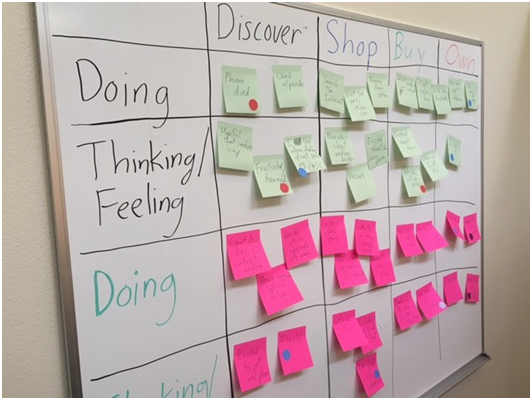WHY CUSTOMER JOURNEY MAPPING IS VALUABLE
Customer journey mapping is a valuable but frequently underestimated tool for marketing. As proven over and over by brands that create outstanding customer experiences, the joy is in the details. Take Disney, for example: whether it be the landscape, structures, or character interactions with guests, every element of a Disney park visit must exude wonder and magic. The process of journey mapping, then, enables brands to identify those make-or-break moments and change them for the better.
While user experience (UX) comes into play with specific pieces of marketing (e.g. website interface or an advertisement through a specific medium), customer experience (CX) is focused on a higher level. Customer experience takes every touchpoint into account, be it a human representative, a printed brochure or a mobile app.
How can companies and brands accurately capture the details?

Recent UX Workshop
At Mapping the Customer Experience – An Interactive Workshop hosted by the Detroit UX Meetup Group, attendees walked through a buying experience step by step as customers. Attendees were split into 5 groups and asked to remember the last time they purchased a mobile phone. Each group member had a unique experience, but the common steps and touchpoints for each group were combined into a common/representative buying experience.
Key Elements of Customer Journey Mapping
Identify these elements to build your journey map:
- Phases of the journey
Depending on the client or product the phases might be a bit different, but most journeys can be broken down into these four phases:
- Discover − initially learning about the product or service, or having a need
- Shop − researching, comparing, looking either online or at physical store
- Buy − all actions between deciding on the product and receiving the product
- Own − if/how a product affects life, customer service issues, etc.
- Doing
Identify all of the steps/actions a customer takes in each phase. These can be concrete such as “search the Internet” or “swipe a credit card” or less tangible, such as “compare products.” This is the “Doing” or “Action” line.
- Thinking/Feeling
Identify thoughts/feelings associated with each action listed above. “Thinking” and “Feeling” can be separate lines in the chart, or they can be combined into one line since thoughts and feelings can overlap. If it is difficult to bring single words to mind, phrases started with the below can help nail these down.
- “I love it when…”
- “I hate it when…”
- “I want…”
- “I need…”
- Feeling lost, anxious, happy, sad, angry, excited, annoyed, etc.
- Pain points
In the workshop, each person received three red dot stickers and placed them along the journey on elements that caused them the most annoyance, frustration, or confusion. Clusters of dots indicate areas the company should focus on for improvement.
- Moments of truth:
Likewise, each person received three green dots to indicate highlights of the experience, or “moments that matter.” These are the elements the company really rocks at. Brands can analyze these elements and see how they can adjust other steps along the way to match these highs.
Takeaways on Customer Journey Mapping
The most notable benefit of this type of exercise is that customers themselves recount a journey they had, instead of marketers trying to guess at the process. The customer his/herself can recall and verbalize many more thoughts, feelings, and actions (some of which are surprising and unexpected) than an observer would guess. If companies have budgets and willing participants, try to interview current customers and have them narrate their buying journey to the company. Even if the overall experience is positive, there will be annoyances and pain points that surface in the retelling that a customer would not normally report to the company.
Journey mapping can instruct companies on how to truly connect the dots for seamless, memorable, outstanding experience.
Thread Marketing Group understands websites are complex brand experiences. Learn more about how our strategy, creative design, technology, and information teams all work together towards effective integrated solutions.

